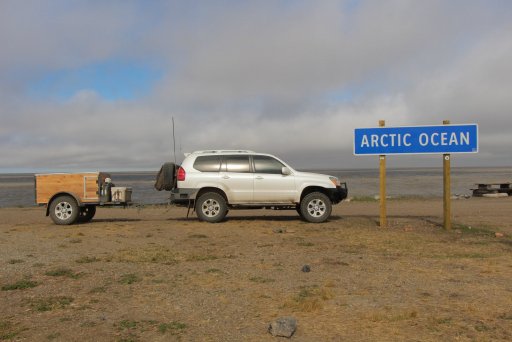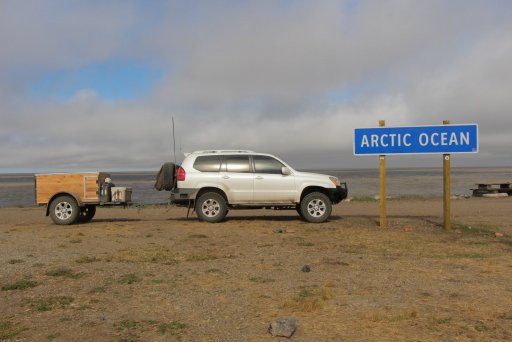Given your needs/uses, a recommend a trailer. And Oregon seems so trailer friendly. I don't know if you could fit 2 plus a 60lb dog in a standard teardrop/squaredrop though. I like the idea of a a squaredrop with 1-2 tip outs. Here is the idea.... but I don't know of any company that offers a more "off-road-able" version.I appreciate your well thought out input on this topic. My wife and have been talking about a trailer, since we are getting up in age and trying to haul a 60# dog up a ladder into a RTT just does not sound like fun. We are also taking into consideration it could be our bug-out accommodation should we experience a fire evacuation order like what happened during the summer of 2020. While a trailer would not be a long-term solution, it could keep us safe for a week or so providing we had access to utilities.
Overland Trailers - first-hand experience: the Good, the Bad and the Ugly
- Thread starter tjZ06
- Start date
How many are you? If one or two people why are you ruling out sleeping inside, out of interest?My rationale for a trailer is as follows:
-TJ
- The WJ is a great, relatively small size - but that means less storage space than say a JLUR and more importantly it's just not going to work out well for me to sleep inside
- With sleeping inside mostly ruled out ...
I appreciate that some like to have more kit than others, and it also depends on your style of travel, however if you add a trailer you'll take more stuff, and I wonder whether you really need the extra mass, drag, tyres, etc., etc.
We have chosen not to add either a RTT or a trailer, and have been able to travel for up to 11 months at a time without feeling a need to have more kit. In fact over the last big trips we have progressively reduced the amount of stuff we've taken. Now this means, for example, a small refrigerator - enough for 5-7 days - so if you're away from resupply for longer it'll get harder (the food mainly). However our experience is that we can carry everything we want in the vehicle. If you plan to establish a base camp and then do more demanding trails from there over a few days then a trailer may be a good option, although our experience is that we can set up and break camp in only a few minutes (a few minutes more if we've extended one or both awnings), and then head out for a day, either returning to the same site and setting up again at the end of the day, or continuing to the next place.
A trailer may well be your best option, however I thought I'd raise the question.

Advocate III
.
Having a good off-road trailer allows you to do the below, whenever and wherever you want, and, if designed well, to any degree of setup, from just using the RTT, or just the kitchen setup, or just the awning, just tailgate, or full monty with everything.
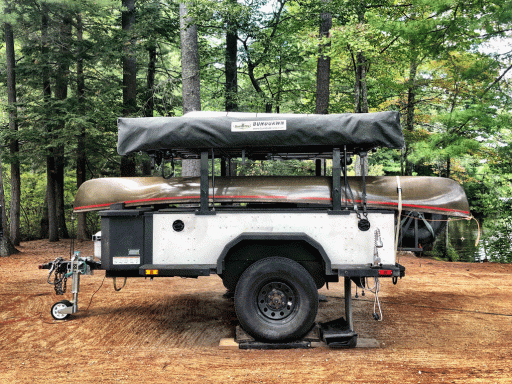
Design your setup right and it will be super flexible and adaptable to a wide variety of uses and scenarios and be easy and quick to deploy, to use, and to pack back up when done.
I'm so used to this setup--a couple years and well over 600 nights out all over America--and use a "lane" system for loading, stowing, and unpacking, that it honestly takes me less than half an hour by myself to do a complete set-up, from unhooking and leveling trailer to sitting and having a beer.
In the short time-lapse vid below, showing time at start and finish and without really hustling, I have it all set up in 18 mins, including solar panels, full kitchen and pantry, firewood bench and raking camp clean.
View attachment 18min-setup_8215.mov
I do a lot of both camping for just one night, get up and go, and staying for extended basecamping. The thing I like about having my trailer is that it vastly extends my back country capabilities and allows me to set up for both, quickly and easily. I love setting up extended basecamps like below, from which I can venture forth for exploring all day either on foot or with my van, and return and get right to cooking and relaxing.
With my trailer I can haul more gear, set up and be more comfortable with far more room than if just using a vehicle, and don't have to pack up awning etc if just hitting a trail or going into town for supplies.
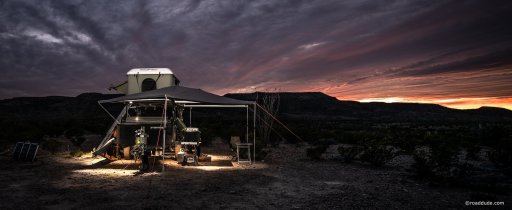
Borderlands, Rio Grande River, Mexico in the background.
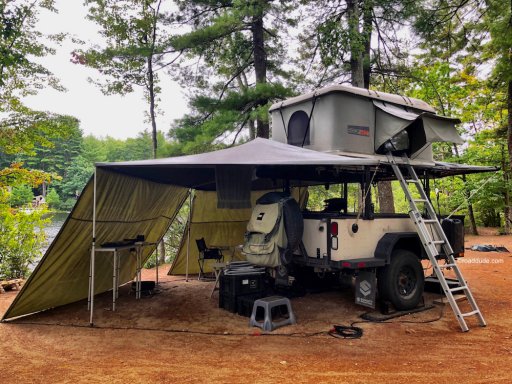
Shade walls from awning, lake camping.
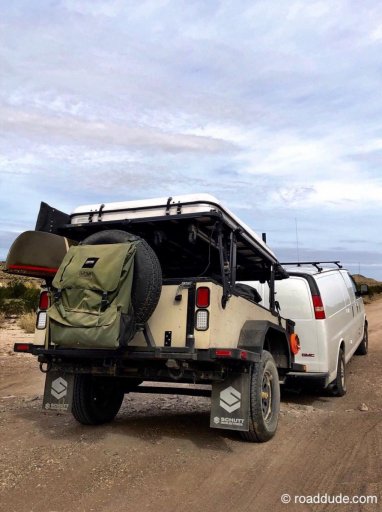
I have yet to find a trail that my trailer kept me back from exploring.
Another trailer thread: Worth the Expense?
 www.overlandbound.com
www.overlandbound.com
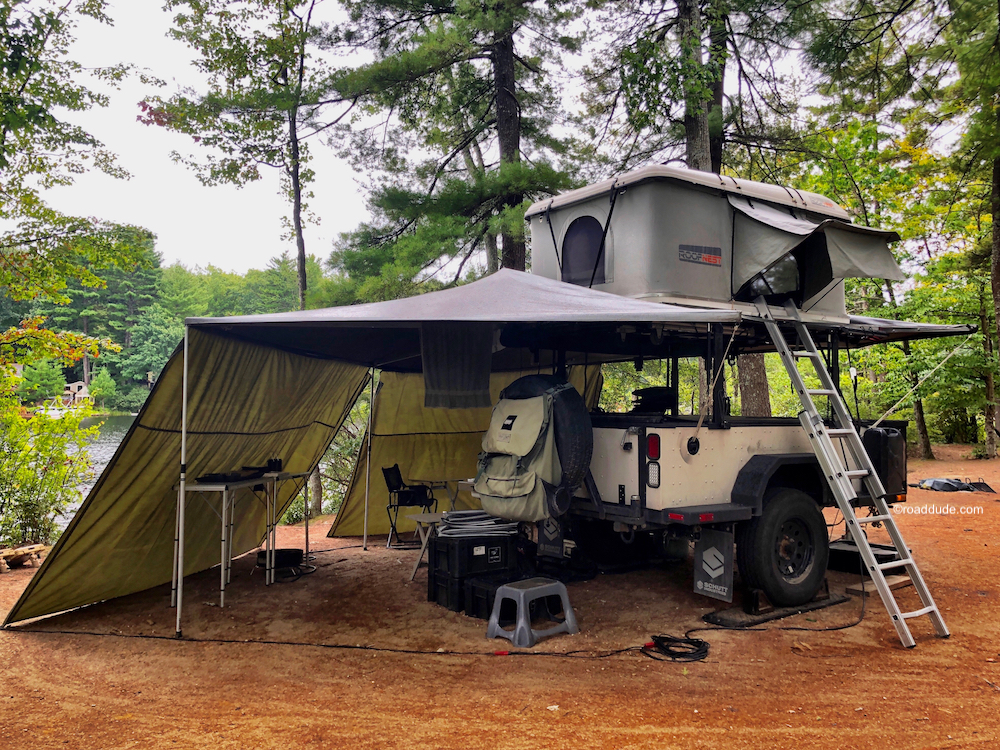
 roaddude.com
roaddude.com
.
Having a good off-road trailer allows you to do the below, whenever and wherever you want, and, if designed well, to any degree of setup, from just using the RTT, or just the kitchen setup, or just the awning, just tailgate, or full monty with everything.

Design your setup right and it will be super flexible and adaptable to a wide variety of uses and scenarios and be easy and quick to deploy, to use, and to pack back up when done.
I'm so used to this setup--a couple years and well over 600 nights out all over America--and use a "lane" system for loading, stowing, and unpacking, that it honestly takes me less than half an hour by myself to do a complete set-up, from unhooking and leveling trailer to sitting and having a beer.
In the short time-lapse vid below, showing time at start and finish and without really hustling, I have it all set up in 18 mins, including solar panels, full kitchen and pantry, firewood bench and raking camp clean.
View attachment 18min-setup_8215.mov
I do a lot of both camping for just one night, get up and go, and staying for extended basecamping. The thing I like about having my trailer is that it vastly extends my back country capabilities and allows me to set up for both, quickly and easily. I love setting up extended basecamps like below, from which I can venture forth for exploring all day either on foot or with my van, and return and get right to cooking and relaxing.
With my trailer I can haul more gear, set up and be more comfortable with far more room than if just using a vehicle, and don't have to pack up awning etc if just hitting a trail or going into town for supplies.

Borderlands, Rio Grande River, Mexico in the background.

Shade walls from awning, lake camping.

I have yet to find a trail that my trailer kept me back from exploring.
Another trailer thread: Worth the Expense?
Is an overland trailer really worth the expense?
Cost a lot compared to a truck bed or tent. What about offroad trails that are hard to maneuver in?

Gear - ROADDUDE
I’ve used a ton of different gear and tools in my travels over the years. Some gear has been great, some lousy, some just so-so. #NoAffiliation – #NotSponsored All of the gear and products below were purchased at the same prices anyone else pays. Bunduawn 360: My Awesome Awning From Bundutec...
 roaddude.com
roaddude.com
.
Attachments
-
14.3 MB Views: 8
Last edited:

Advocate I
Fair points. I was mostly curious about the NoBos in general, not becaues they'd be right for me. Obviously the price-point is attractive compared to the 'real' off-road ones, but there's a reason. And yes, I know anything can be broken if you try hard 'nough... and anything can survive if you try hard 'nough too. ;) I crew up doing a lot of wheelin' and rock crawling, and I've watched fully built rigs on one-ton axles (built axles too, not OEM shafts etc.) break things in spots we could take a Sami on stock axles (stock shafts 'n all) through. It just takes more patience, care and in some cases skill. That said, I don't want to end up in a situation where I need to go absurdly slow on even mild trails and hold up my entire group at all times.Towing on something like that just means you need to set/place the trailer wheels as carefully as you plan where the front tires go. And factory 4LO might not be slow enough. But asking someone "will it survive" is impossible to answer. Survival is up to the driver. Some people can break anything.
That said, the NoBo is an entry level, kinda cool, maybe capable forestry road camper. BUT the trails you show indicate your rear tires might climb rocks you missed with the front tires..... and the trailer regardless of who is driving is going to high center and drag over the rock.... or hang up and destroy itself. Regardless of the trailer it would take a skilled driver to get thru unscathed.
Given your needs/uses, a recommend a trailer. And Oregon seems so trailer friendly. I don't know if you could fit 2 plus a 60lb dog in a standard teardrop/squaredrop though. I like the idea of a a squaredrop with 1-2 tip outs. Here is the idea.... but I don't know of any company that offers a more "off-road-able" version.
Replying to these two together, since they brought up similar topics.How many are you? If one or two people why are you ruling out sleeping inside, out of interest?
I appreciate that some like to have more kit than others, and it also depends on your style of travel, however if you add a trailer you'll take more stuff, and I wonder whether you really need the extra mass, drag, tyres, etc., etc.
We have chosen not to add either a RTT or a trailer, and have been able to travel for up to 11 months at a time without feeling a need to have more kit. In fact over the last big trips we have progressively reduced the amount of stuff we've taken. Now this means, for example, a small refrigerator - enough for 5-7 days - so if you're away from resupply for longer it'll get harder (the food mainly). However our experience is that we can carry everything we want in the vehicle. If you plan to establish a base camp and then do more demanding trails from there over a few days then a trailer may be a good option, although our experience is that we can set up and break camp in only a few minutes (a few minutes more if we've extended one or both awnings), and then head out for a day, either returning to the same site and setting up again at the end of the day, or continuing to the next place.
A trailer may well be your best option, however I thought I'd raise the question.
I'm in Northern CA actually, but I definitely see my trips taking me to Oregon, ID, etc. Anyway, for most of my "Overland" trips it'd just be me. We have an RV and the wife and dogs (it's just us and the dogs, no kids) like those trips. She's a very outdoorsy person and might enjoy Overlanding if we had a trailer, but IDK if it'd make sense with the dogs. Our dogs are schmedium (~30lbs each) but they are very much our kids, and she just doesn't really relax with them in real outdoor settings. With the RV she can put them inside and they still have space to play and stuff, so she can get a break from having them with us outside when she wants. Alas, our dogs will never be "just dogs" so I can't imagine her letting them just hangout off leash out in the woods. Anyway, the point being it'd be just me a lot, but I'm sure occasionally she'd find a dog-sitter and come out for a trip - and in those cases the trailer would be a big plus, but she's really the type of person that's fine sleeping in a tent... she just worries about the dogs too much for *them* to sleep in a tent, lol.
As for why not sleep *in* the WJ, really it's just a matter of space. WJs are much smaller than people realize. For example, here are the rear hatch dimensions...
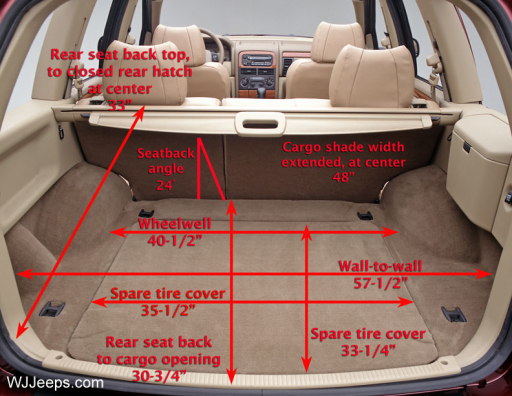
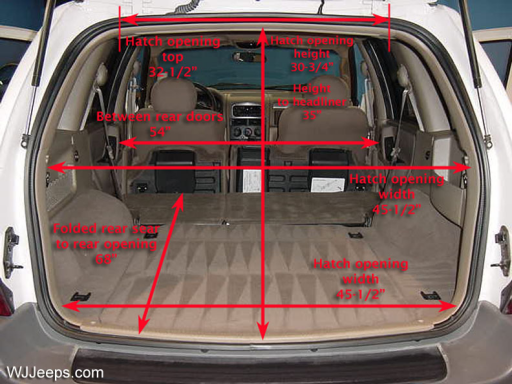
As you can see, even with the back seats folded you only have 68" from the tailgate to the bottoms of the rear seats which flip forward. I like to say I'm 6'... but I'm probably more like 5' 11", which is still 71" or 3" too fit in the hatch... and that's laying on my back with my feet pointing straight out. I'm more of a side-sleeper, and tend to have an arm up above/under my head and perhaps my feet angled down a bit. I had thought about eliminating the rear seats entirely (again, no kids) and then having a platform that would fold-forward. That way when you get to your camp spot you slide both front seats as far forward as possible then flip an "extension" forward on the sleeping platform. I was thinking it maybe be elevated up at the wheel-well height with drawers underneath, and "access hatches" in the front portion to utilize the space where the rear seats used to be (this would also put it high enough to flip on top of the center console/arm rest thing when the front seats are forward).
While I think that setup would work, and be pretty slick, at the end of the day it still ends up being a pretty tight sleeping quarters. And the other downside is that everything has to come out of the rig in order to setup your sleep area. That's fine and dandy in good weather, but if rain comes all of your stuff is out getting rained on. If you pack wisely and use sealed plastic tubs, it's not a huge deal, and things like your bag of clothes could probably just go on the front seats, so it's not a show-stopper. However, most everyone I've talked to who sleeps in their rigs recommend a bigger vehicle with more room to stretch out and a little room to have some gear stay inside, safe and dry.
@Truckee
That looks like a nice rig, but the ones I'm looking at are a bit more rugged yet:
@Alanymarce
You definitely raise some good points about just simplifying the load out, knowing you'll hit resupply spots, and not complicating things with a trailer. I'm not convinced a trailer is right for me yet, especially because of the cost.
Thank you both for your input!
Awesome setup, and thanks so much for sharing your experience. I agree on all of your points about the advantages of the trailer..
Having a good off-road trailer allows you to do the below, whenever and wherever you want, and, if designed well, to any degree of setup, from just using the RTT, or just the kitchen setup, or just the awning, just tailgate, or full monty with everything.
View attachment 187340
Design your setup right and it will be super flexible and adaptable to a wide variety of uses and scenarios and be easy and quick to deploy, to use, and to pack back up when done.
I'm so used to this setup--a couple years and well over 600 nights out all over America--and use a "lane" system for loading, stowing, and unpacking, that it honestly takes me less than half an hour by myself to do a complete set-up, from unhooking and leveling trailer to sitting and having a beer.
In the short time-lapse vid below, showing time at start and finish and without really hustling, I have it all set up in 18 mins, including solar panels, full kitchen and pantry, firewood bench and raking camp clean.
View attachment 187341
I do a lot of both camping for just one night, get up and go, and staying for extended basecamping. The thing I like about having my trailer is that it vastly extends my back country capabilities and allows me to set up for both, quickly and easily. I love setting up extended basecamps like below, from which I can venture forth for exploring all day either on foot or with my van, and return and get right to cooking and relaxing.
With my trailer I can haul more gear, set up and be more comfortable with far more room than if just using a vehicle, and don't have to pack up awning etc if just hitting a trail or going into town for supplies.
View attachment 187343
Borderlands, Rio Grande River, Mexico in the background.
View attachment 187353
Shade walls from awning, lake camping.
View attachment 187352
I have yet to find a trail that my trailer kept me back from exploring.
Another trailer thread: Worth the Expense?
Is an overland trailer really worth the expense?
Cost a lot compared to a truck bed or tent. What about offroad trails that are hard to maneuver in?www.overlandbound.com

Gear - ROADDUDE
I’ve used a ton of different gear and tools in my travels over the years. Some gear has been great, some lousy, some just so-so. #NoAffiliation – #NotSponsored All of the gear and products below were purchased at the same prices anyone else pays. Bunduawn 360: My Awesome Awning From Bundutec...roaddude.com
.
-TJ
you’ve obviously thought abiut it seriously which I think is great. I looked at the interior dimensions of your vehicle when looking at buying for a long Canada trip. As you say - it’s tight (and we’re 174 cm and 169 Cm). We cocnluded that it was feasible. Our set up folds (although we don’t use this capability much) and everything fits below the bed, however our vehicle is bigger. You’d need a low profile fridge and storage drawers. So we don’t have to take anything out if it’s raining, and don’t take much out even if it’s not. If you’re interested in more details I can PM some photos of how we’ve done this.tjZ06 said:187365[/ATTACH]
View attachment 187367
As you can see, even with the back seats folded you only have 68" from the tailgate to the bottoms of the rear seats which flip forward. I like to say I'm 6'... but I'm probably more like 5' 11", which is still 71" or 3" too fit in the hatch... and that's laying on my back with my feet pointing straight out. I'm more of a side-sleeper, and tend to have an arm up above/under my head and perhaps my feet angled down a bit. I had thought about eliminating the rear seats entirely (again, no kids) and then having a platform that would fold-forward. That way when you get to your camp spot you slide both front seats as far forward as possible then flip an "extension" forward on the sleeping platform. I was thinking it maybe be elevated up at the wheel-well height with drawers underneath, and "access hatches" in the front portion to utilize the space where the rear seats used to be (this would also put it high enough to flip on top of the center console/arm rest thing when the front seats are forward).
While I think that setup would work, and be pretty slick, at the end of the day it still ends up being a pretty tight sleeping quarters. And the other downside is that everything has to come out of the rig in order to setup your sleep area. That's fine and dandy in good weather, but if rain comes all of your stuff is out getting rained on. If you pack wisely and use sealed plastic tubs, it's not a huge deal, and things like your bag of clothes could probably just go on the front seats, so it's not a show-stopper. However, most everyone I've talked to who sleeps in their rigs recommend a bigger vehicle with more room to stretch out and a little room to have some gear stay inside, safe and dry.
You definitely raise some good points about just simplifying the load out, knowing you'll hit resupply spots, and not complicating things with a trailer. I'm not convinced a trailer is right for me yet, especially because of the cost
Sorry for the confusion. My post was directed to Glacierdog in Oregon. Ironically, he has a 60 lb dog but you have 2 dogs equalling 60 lbs!Replying to these two together, since they brought up similar topics.
I'm in Northern CA actually, but I definitely see my trips taking me to Oregon, ID, etc. Anyway, for most of my "Overland" trips it'd just be me. We have an RV and the wife and dogs (it's just us and the dogs, no kids) like those trips. She's a very outdoorsy person and might enjoy Overlanding if we had a trailer, but IDK if it'd make sense with the dogs. Our dogs are schmedium (~30lbs each) but they are very much our kids, and she just doesn't really relax with them in real outdoor settings. With the RV she can put them inside and they still have space to play and stuff, so she can get a break from having them with us outside when she wants. Alas, our dogs will never be "just dogs" so I can't imagine her letting them just hangout off leash out in the woods. Anyway, the point being it'd be just me a lot, but I'm sure occasionally she'd find a dog-sitter and come out for a trip - and in those cases the trailer would be a big plus, but she's really the type of person that's fine sleeping in a tent... she just worries about the dogs too much for *them* to sleep in a tent, lol.
@Truckee
That looks like a nice rig, but the ones I'm looking at are a bit more rugged yet:
Anyway, something that I haven't heard mentioned... one nice aspect of my trailer was it had the same width as my vehicle. This made it really nice off-road as it followed my tracks closely and I didn't have to look at my side mirrors nearly as often. The trailer tires didn't "cheat" much around turns, trees and rocks. I'm sure there are a lot of small benefits like lessoning the chance of trailer tire punctures, less rolling resistance when traveling over sand/dirt roads as the tires follow the tow vehicle tracks.

Member III
Sorry if I missed what someone else said here but, I wanted to comment on this. Your comment was more geared to "heavy/moderate" trails and your picks showed articulation over deep ruts and rocks. Here's my experience with modified trailers over several decades.Do those NoBos hold up to *real* off road use? I'm not talking the Rubicon or anything, but what about trials something like:
I got my M-100 30 odd years ago. I use to maintain some of the black diamond Jeep trails in my local mountains. The trailers main purpose in life was hauling gear and materials up and down the trails. I learned a few things very quickly. The length of my hitch was critical so the trailer followed the vehicle track exactly. The trailer tires needed to stick out to the sides more to protect the body or like one of my buddies did, add in rock sliders. Ideally, the width matched the tow vehicle also.
When driving offroad, I would move the weight back to where you have a balanced trailer and zero tongue weight. The tongue weight drastically effects how the back of your vehicle articulates offroad. I found it best if I was "pulling" the weight rather than "supporting" part of it on a hitch.
The single most important part was the hitch I had to make. I needed to build a 3 axis hitch that had a stop in it to prevent the trailer from flipping upside down. In other words I could not allow a 360 degree "twist". A pintle hitch was ideal but I couldn't stand the noise when I removed the tongue weight.
Moving forward. All this happened before RTT's. The trailer at times had gear, others it could be completely filled with rocks to be used on a water crossing several miles down a Black Diamond trail. The trailer had (at that time) traveled a number of other black diamond trails including the Rubicon and the Dusy trail (camping not maintaining)
When RTT's first came out I decided to use the trailer more for camping. Rebuilt it and added the RTT. This added more weight up high and the road manners changed a bit on the trail. With the RTT on top it has traveled a number of Black diamond trails including the Rubicon. When I went from my CJ7 to my TJ, I had to lengthen the hitch to get the trailer to follow my track. Also, on two occasions the stops I put into my hitch prevented me from flipping the trailer upside down onto the RTT. Both were fluke's and wasn't me being stupid. One of them was almost exactly like your heavy twist in one of your pictures.
Now to the real reason for me replying to the comment. My hard side is built similar to my M-100. It will follow me perfectly, I have rock slider steps and in the couple of trips it's gone on, has been dragged through what I would call "Moderate" trail's. Heavy ruts', small boulders. If I were to buy a trailer it would have to have a width that matched my vehicle, tongue that matched my length and the ability to shift weight back for dirt travel. I would of course build a new hitch with the proper stops. If I were to drag the hard side down a black diamond trail in the mountains, I have no doubt due to the height ("6ft") I will probably end up tilting it into a tree and the overhang behind the axle would swing out and hit something on a tight corner. None of these I worried about with the M-100. Desert wouldn't be an issue but I have no desire to do black diamonds with my camper. I no longer have my TJ and my Cruiser doesn't have lockers. That alone will keep me away from Black Diamonds.
I loved the fact that my little trailer went everywhere but it did drag on the back of the vehicle and sometimes made things hard to drive over. I couldn't imagine dragging some of those other's down even a moderate trail. The overall weight of the trailer and how far the axle is pushed back on some, you not only wont have it close to your track but the tongue weight is huge. Granted you need some tongue weight for highway driving but some of them are way too high. Someone mentioned the expensive Australian trailers, take a look at the overall size and weight on those things. One of my buddies has one. I'm glad he pulls it with a full sized truck.
I'm leaving out some details on trailer build. When people build trailers, they tend to build a "trailer". What we need for moderate trails (or more) is an "Off-Road Vehicle" with a sleeping compartment.
Yeah, this turned into another of my lengthy posts (I did edit it down too). Hopefully it gives a little perspective.
Last edited:

Advocate I
I'm always interested in other setups, so sure feel free to send me a few pics. That said, changing the vehicle out at this point is not an option. I love my WJ, and I'm (far too) heavily invested in it. I suppose I shouldn't totally rule out the interior build-out as I described above and sleeping in it, at least when it's just me only. Like you said and elevated platform that has a smaller drawer-type fridge and then a big storage drawer under it would mean I wouldn't have to unload *everything* at camp - that's a good point. Perhaps I'd just have a few tubs with things like tools and spares that I'd dump out, but as long as they are waterproof then no big deal. Thank you for the help.you’ve obviously thought abiut it seriously which I think is great. I looked at the interior dimensions of your vehicle when looking at buying for a long Canada trip. As you say - it’s tight (and we’re 174 cm and 169 Cm). We cocnluded that it was feasible. Our set up folds (although we don’t use this capability much) and everything fits below the bed, however our vehicle is bigger. You’d need a low profile fridge and storage drawers. So we don’t have to take anything out if it’s raining, and don’t take much out even if it’s not. If you’re interested in more details I can PM some photos of how we’ve done this.
Gotcha re: Oregon confusion. That's a good point about trackwidth, I'll need to look into that. I actually think the trailer I have my eye on might be narrower track. Though, I'd be adding adapters to go from the stock 6x5.5" bolt pattern to 5x5" so I can run all the same wheels/tires on both units, that way I have 2 spares (already have a fullsize spare on my WJ) that would work on either unit if needed. Thanks for the help.Sorry for the confusion. My post was directed to Glacierdog in Oregon. Ironically, he has a 60 lb dog but you have 2 dogs equalling 60 lbs!
Anyway, something that I haven't heard mentioned... one nice aspect of my trailer was it had the same width as my vehicle. This made it really nice off-road as it followed my tracks closely and I didn't have to look at my side mirrors nearly as often. The trailer tires didn't "cheat" much around turns, trees and rocks. I'm sure there are a lot of small benefits like lessoning the chance of trailer tire punctures, less rolling resistance when traveling over sand/dirt roads as the tires follow the tow vehicle tracks.
Great info and real world experience, thanks so much!Sorry if I missed what someone else said here but, I wanted to comment on this. Your comment was more geared to "heavy/moderate" trails and your picks showed articulation over deep ruts and rocks. Here's my experience with modified trailers over several decades.
I got my M-100 30 odd years ago. I use to maintain some of the black diamond Jeep trails in my local mountains. The trailers main purpose in life was hauling gear and materials up and down the trails. I learned a few things very quickly. The length of my hitch was critical so the trailer followed the vehicle track exactly. The trailer tires needed to stick out to the sides more to protect the body or like one of my buddies did, add in rock sliders. Ideally, the width matched the tow vehicle also.
When driving offroad, I would move the weight back to where you have a balanced trailer and zero tongue weight. The tongue weight drastically effects how the back of your vehicle articulates offroad. I found it best if I was "pulling" the weight rather than "supporting" part of it on a hitch.
The single most important part was the hitch I had to make. I needed to build a 3 axis hitch that had a stop in it to prevent the trailer from flipping upside down. In other words I could not allow a 360 degree "twist". A pintle hitch was ideal but I couldn't stand the noise when I removed the tongue weight.
Moving forward. All this happened before RTT's. The trailer at times had gear, others it could be completely filled with rocks to be used on a water crossing several miles down a Black Diamond trail. The trailer had (at that time) traveled a number of other black diamond trails including the Rubicon and the Dusy trail (camping not maintaining)
When RTT's first came out I decided to use the trailer more for camping. Rebuilt it and added the RTT. This added more weight up high and the road manners changed a bit on the trail. With the RTT on top it has traveled a number of Black diamond trails including the Rubicon. When I went from my CJ7 to my TJ, I had to lengthen the hitch to get the trailer to follow my track. Also, on two occasions the stops I put into my hitch prevented me from flipping the trailer upside down onto the RTT. Both were fluke's and wasn't me being stupid. One of them was almost exactly like your heavy twist in one of your pictures.
Now to the real reason for me replying to the comment. My hard side is built similar to my M-100. It will follow me perfectly, I have rock slider steps and in the couple of trips it's gone on, has been dragged through what I would call "Moderate" trail's. Heavy ruts', small boulders. If I were to buy a trailer it would have to have a width that matched my vehicle, tongue that matched my length and the ability to shift weight back for dirt travel. I would of course build a new hitch with the proper stops. If I were to drag the hard side down a black diamond trail in the mountains, I have no doubt due to the height ("6ft") I will probably end up tilting it into a tree and the overhang behind the axle would swing out and hit something on a tight corner. None of these I worried about with the M-100. Desert wouldn't be an issue but I have no desire to do black diamonds with my camper. I no longer have my TJ and my Cruiser doesn't have lockers. That alone will keep me away from Black Diamonds.
I loved the fact that my little trailer went everywhere but it did drag on the back of the vehicle and sometimes made things hard to drive over. I couldn't imagine dragging some of those other's down even a moderate trail. The overall weight of the trailer and how far the axle is pushed back on some, you not only wont have it close to your track but the tongue weight is huge. Granted you need some tongue weight for highway driving but some of them are way too high. Someone mentioned the expensive Australian trailers, take a look at the overall size and weight on those things. One of my buddies has one. I'm glad he pulls it with a full sized truck.
I'm leaving out some details on trailer build. When people build trailers, they tend to build a "trailer". What we need for moderate trails (or more) is an "Off-Road Vehicle" with a sleeping compartment.
Yeah, this turned into another of my lengthy posts (I did edit it down too). Hopefully it gives a little perspective.
With respect to width, sliders, etc. I would be adding an adapter as mentioned above, so that should have the tires just slightly outside the fenders. The fenders are also specifically designed to be easily replaceable, as the trailer is truly intended for "real" offroad use. It also has big slider/tree kicker type things which should help protect the actual "body" from damage. Very interested input about the tongue weight. I'm not sure how much I'd be able to shift weight back when I got to the trail head, since the square drops sort of have a place where everything specifically goes (which, of course has big upsides). Still, I could see doing as much as I could. I think even with the road-going tongue weight it'd still mean less total weight on the rear axle of my Jeep than a regular camping load out with everything having to be *in* the hatch.
It's funny you mentioned the hitch: I was thinking the same thing. The fully articulating "Max Coupler" style hitches seem like they'd let the trailer flop too easily, and I've seen more than one video of that happening. Obviously there's a give and take between limiting articulation between tow rig and trailer too much putting things into a bind vs. full articulation which gives the trailer no added stability from the tow rig.
I don't think I'd be looking to do any Black Diamond trails with a trailer. I do intend to take the WJ through the Rubicon, but I wouldn't want to pull a trailer for that. Which brings me to one of the drawbacks to a trailer for me: I wouldn't use it on every trip. There are snow trips my buddies do that would just be too tough/sketchy with a trailer. Then there's the Rubicon and some of the other black diamond trails all around me (I live in Lincoln, CA... so the Rubicon is what, 1.5 hrs from me?). Of course, that said I don't see doing a *lot* of snow wheeling/camping. It's just not "my thing so much, plus we spend most of our free time in the winters down south going to Glamis and doing sand rail/SxS stuff. I also don't think I'll do the Rubicon a lot. I *have* to do it once, because I grew up dreaming about it, and like I said I'm so close. But I'm just over my days of all day to go 2 miles, your spotter can walk faster than you are going to drive, and 110% likelihood you'll be recovering and fixing broken rigs. Also, none of my buddies are into that level of wheeling anymore (several had crawlers, even full-on "truggy" builds) and we're all much more intrested in getting out in the woods (or desert) on some mildly tough trials that thins down the crowds, but enjoying nature and relaxing - not spending all day just trying to un-effe the effe'ed up situation we got ourselves into. ;)
BTW, don't feel bad about the lengthy post - if you look through my threads you'll see I tend to be overly verbose. ;) I enjoyed the read, thanks again!
-TJ
the only way to do this is by having EVERYTHING in the trailer and keeping the SUV sleeping area PERMANENTLY set up.it still ends up being a pretty tight sleeping quarters. And the other downside is that everything has to come out of the rig in order to setup your sleep area
Yer dogs will love having the entire bed to sprawl in while travelling.
My only goal is to eliminate any setup, packup while travelling. Make that your goal. Find a way to never need to setup or packup.
Most RTT, Expo Trailer setups are intensive labour setup, packup plus if it is raining during packup...... you pray for sunshine at the next stop.
Might be tight, but it is always dry and secure..... in an emergency you can sleep in the SUV anywhere.... securely.
Setup the bedroom in the back... excellent choice.
Last edited:

Advocate I
That's interesting, I hadn't even thought of making the SUV the sleeping area and more or less perm setup then moving ALL gear into a smaller trailer. This would allow for a much smaller (and cheaper) trailer. Hmmm. Downside is with the WJ the sleeping platform would still need to somewhat "convert" no matter what, since it'd have to flip-forward once the driver/passenger seat are slid forward to make the area long enough. Not really a big deal.the only way to do this is by having EVERYTHING in the trailer and keeping the SUV sleeping area PERMANENTLY set up.
Yer dogs will love having the entire bed to sprawl in while travelling.
My only goal is to eliminate any setup, packup while travelling. Make that your goal. Find a way to never need to setup or packup.
Most RTT, Expo Trailer setups are intensive labour setup, packup plus if it is raining during packup...... you pray for sunshine at the next stop.
Might be tight, but it is always dry and secure..... in an emergency you can sleep in the SUV anywhere.... securely.
Setup the bedroom in the back... excellent choice.
-TJ

Influencer I
- 3,073
- First Name
- Chris
- Last Name
- Nygren
- Member #
-
25841
- Ham/GMRS Callsign
- KK7KJK
I agree. It has been tough trying to see if my Weimaraner (dog), my wife and I would all squeeze into a teardrop-esque trailer. We have a queen sized bed in one of our spare bedrooms and tried sleeping in there with the dog for a couple nights. A couple of points...Given your needs/uses, a recommend a trailer. And Oregon seems so trailer friendly. I don't know if you could fit 2 plus a 60lb dog in a standard teardrop/squaredrop though. I like the idea of a a squaredrop with 1-2 tip outs. Here is the idea.... but I don't know of any company that offers a more "off-road-able" version.I appreciate your well thought out input on this topic. My wife and have been talking about a trailer, since we are getting up in age and trying to haul a 60# dog up a ladder into a RTT just does not sound like fun. We are also taking into consideration it could be our bug-out accommodation should we experience a fire evacuation order like what happened during the summer of 2020. While a trailer would not be a long-term solution, it could keep us safe for a week or so providing we had access to utilities.
1. My dog sleeps very warm and thus tries to stretch out when she hits that temperature threshold. That means my wife and I get pushed to the edges. That's not a good thing.
2. On cold nights, my dog moves north on the bed in attempt to lay on our pillows between us. Again, the same result, we are pushed to the edge.
Possible solution for us would be to install a RTT on the trailer where I could sleep easily and the dog and wife could be down inside the trailer.
There are other details we will need to work out before we pull the trigger and purchase one. One detail was a shelf above the foot area that can be a bed complete with a pad. If my dog would sleep there all night, that would solve everything. I may have to mock something up here at the home first. (Plywood is way cheaper then that shelf trailer option or a RTT.)

Member III
Possibly a fold down shelf with a dog bed. I have a small one and am installing a large one to act as a eating/computer table. My dog on the other hand wouldn't stay on her "dog bed" if she could cuddle with me. Which of course means she has control of the bed and has no problem pushing me off, stealing the pillow or kicking me during the night.There are other details we will need to work out before we pull the trigger and purchase one. One detail was a shelf above the foot area that can be a bed complete with a pad. If my dog would sleep there all night, that would solve everything. I may have to mock something up here at the home first. (Plywood is way cheaper then that shelf trailer option or a RTT.)
I'm currently using the smaller version of these. Folding Hinge. There are several lengths and weight capacities, this is just an example.
@Glacierdog Another option for you would be a tent trailer. These have been around for a long time. Simple, lightweight (<l,000lbs) and spacious... and only 60" wide. Doesn't need fancy suspension because it's so light. Not as convenient as a teardrop but it has way more interior space/shelter in case it rains.
 www.kamparoo.com
www.kamparoo.com
Trans Continental Model - by Kamparoo Campers
The Trans-Continental has been constructed solely for rugged off-road use and comes equipped with an increased capacity axle, reinforced frame, chassis & more.
NMBruce
Rank V

Advocate II
- 1,808
- First Name
- Bruce
- Last Name
- Cooper
- Member #
-
27527
- Ham/GMRS Callsign
- KE0NBD
- Service Branch
- U.S. Air Force
this summer the trailer will have a new suspension and Alpha ll RTT on it.
Attachments
-
387.7 KB Views: 26

Advocate I
Haha, our dogs, though smaller do the same thing. In the RV we've gone to crating them, even though the RV has a King bed. Even at home we're moving to crating, it just improves the quality of our sleep so much. The dogs move in and out of the covers, sprawl out sideways, compete to be closest to one of us, etc. There's basically no way we're going to be able to crate the dogs Overlanding. Sure, if we had the trailer I could crate them in the hatch of the WJ - but a) we'd have to figure out heating (or maybe cooling) the space b) we wouldn't be able to hear if they actually need to go out. I think the reality is our dogs just aren't "Overlanders" and that means generally the wife won't be going either. We still do tons of RV-based trips that obviously she goes on, so I think we're both okay with the plan. But occasionally we'll get a dog sitter and she'll come out too.I agree. It has been tough trying to see if my Weimaraner (dog), my wife and I would all squeeze into a teardrop-esque trailer. We have a queen sized bed in one of our spare bedrooms and tried sleeping in there with the dog for a couple nights. A couple of points...
1. My dog sleeps very warm and thus tries to stretch out when she hits that temperature threshold. That means my wife and I get pushed to the edges. That's not a good thing.
2. On cold nights, my dog moves north on the bed in attempt to lay on our pillows between us. Again, the same result, we are pushed to the edge.
Possible solution for us would be to install a RTT on the trailer where I could sleep easily and the dog and wife could be down inside the trailer.
There are other details we will need to work out before we pull the trigger and purchase one. One detail was a shelf above the foot area that can be a bed complete with a pad. If my dog would sleep there all night, that would solve everything. I may have to mock something up here at the home first. (Plywood is way cheaper then that shelf trailer option or a RTT.)
Unless we did crates on the shelves, which I suppose is possible, our dogs would never stay on them, they'd want to be down with us. Still, a neat idea!Possibly a fold down shelf with a dog bed. I have a small one and am installing a large one to act as a eating/computer table. My dog on the other hand wouldn't stay on her "dog bed" if she could cuddle with me. Which of course means she has control of the bed and has no problem pushing me off, stealing the pillow or kicking me during the night.
I'm currently using the smaller version of these. Folding Hinge. There are several lengths and weight capacities, this is just an example.
-TJ

Advocate I
Those definitely are interesting, I might have to look into them a bit more. The light weight and simplicity are certainly nice. Setup wouldn't be bad at all, and once setup it's more space. The only downside would be it doesn't have some of the gucci features like a galley, onboard water (with heater) etc. But that's all stuff I don't have right now anyway with a ground tent. ;) I'm sure I could add some of that stuff over time (the water tank especially - galley not so much).@Glacierdog Another option for you would be a tent trailer. These have been around for a long time. Simple, lightweight (<l,000lbs) and spacious... and only 60" wide. Doesn't need fancy suspension because it's so light. Not as convenient as a teardrop but it has way more interior space/shelter in case it rains.
Trans Continental Model - by Kamparoo Campers
The Trans-Continental has been constructed solely for rugged off-road use and comes equipped with an increased capacity axle, reinforced frame, chassis & more.www.kamparoo.com
EDIT: spent more time on their site (like a lot of small-time manufacturers the site could use some work!!!) and I guess really everything I would want is possible/optional. Water tank. Fridge/freezer. Small pull-out galley. Etc.
Nice rig!this summer the trailer will have a new suspension and Alpha ll RTT on it.
-TJ
NMBruce
Rank V

Advocate II
- 1,808
- First Name
- Bruce
- Last Name
- Cooper
- Member #
-
27527
- Ham/GMRS Callsign
- KE0NBD
- Service Branch
- U.S. Air Force
My home build trailer is based off a M416, has about 40-50K miles on it. I built it on the smaller side for trails.I have used a trailer now for 6 years, mostly to just carry gear. With 3 or 4 people in a JKUR or GX470, there is not much room for anything else and those where really long trips to Alaska and the Arctic Ocean.
This Spring I will be adding a clam shell tent, Alpha ll tent, cost was good $1900, plus it looks easy to open and close and a hard covered.
Like you, I dont want to climb up to the top of a vehicle and so by going on my trailer, it will be only 4.5 feet off the ground. Should I not need the trailer, I will be able to put it on a half rack in a pickup bed.
thought I would show a picture
Attachments
-
387.7 KB Views: 23
I also like the ability to see over and directly behind the trailer vs some of the taller teardrops. A Webasto type heater does a great job of heating the entire tent too. They offer a 19 Gal water tank as an option. They used to offer a slide out kitchen but one could certainly be added as such...Those definitely are interesting, I might have to look into them a bit more. The light weight and simplicity are certainly nice. Setup wouldn't be bad at all, and once setup it's more space. The only downside would be it doesn't have some of the gucci features like a galley, onboard water (with heater) etc. But that's all stuff I don't have right now anyway with a ground tent. ;) I'm sure I could add some of that stuff over time (the water tank especially - galley not so much).

Advocate I
Thanks again for all the help folks, tons of great information here. I lucked-out and an OB member reached out who was selling the perfect trailer for me. I still love the Vorsheer XOC, but I found something a bit smaller, a good bit lighter, and much more affordable (about half what I'd have to pay for a Vorsheer). I'm picking it up Wed...
-TJ
-TJ
Last edited:

Member III
Just to chime in on the sleeping inside a WJ... it's doable but a little on the tight side. I totally eliminated my rear seats and put drop in boxes in there place so it is flat from the rear hatch to the front seats. I thought about raising the platform up to the top of the wheel wells but decided I wanted more head room. I'm about 6' and with the front seats moved forward it is plenty of space for me to sleep in with a couple bags inside. I carry most of my gear in hard plastic totes so if they stay outside in bad weather it isn't a big deal, just put your chair in the front seat so its dry for morning. I wouldn't try to sleep 2 adults in it, but I have slept in it with a 105lb Dane/Mastiff mix. For me it works well enough for solo trips that I haven't started looking at trailers yet and once kids come it was actually my wives idea that we just build her a twin WJ!



